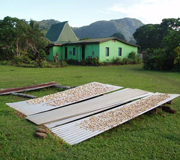 What is the relative vulnerability of rural livelihoods in countries/island types/sub-regions in the Pacific in the face of future?
What is the relative vulnerability of rural livelihoods in countries/island types/sub-regions in the Pacific in the face of future?
- What did the project do?
- What did the project produce?
- How can the project make a difference to development?
- Publications
What did the project do?
This short scoping study undertook an assessment of the relative vulnerability of rural livelihoods in Pacific countries/island types/sub-regions in the context of climate change projections. This was achieved by applying existing knowledge within a strategic research context and:
- identifying the risks, adaptive capacity and hence, vulnerability of key cropping, grazing and forestry activities (focussing primarily on subsistence and cash crop production) in the Pacific region and East Timor to climate change based on current and future constraints to production via:
1. a review of existing literature
2. engagement with key partner country stakeholders working in the area of crop production and climate change assessment research and development - broadly assessing the potential vulnerability of countries/island types/sub-regions and their natural resource base in participation with a selection of representative from regional agricultural, natural resource management, meteorological and development agencies operating throughout the Pacific region. A key activity in the assessment was a participatory workshop held in Fiji (November 2008), where scientific information on crop thresholds and climate projections was synthesised with more empirical, indigenous knowledge provided by the regional representatives. This was undertaken using a modified version of the sustainable livelihood approach (Ellis, 2000)
- reviewing the appropriateness and efficacy of analytical tools and methodologies to further quantify vulnerability either qualitatively and/or quantitatively (e.g. crop simulation modelling and climatic mapping)
- identifying practical, policy-relevant research questions related to the impact of climate change on cropping, grazing and forestry production systems, key information gaps, priorities for future research, capacity building needs and resource requirements. This provided an evidence base to support recommendations for future research.
- 16 Pacific Island countries were included in the study
What did the project produce?
- Broad climate and production thresholds for key cropping, grazing and forestry livelihood activities undertaken in the Pacific region
- An overview assessment of the potential vulnerability of counties/island types/sub-regions and the natural resource base to a changing climate
- Linkages and capacity building with key country, region and industry decision-makers working in the areas of climate change and rural livelihood activities
- Documentation of future key information gaps and recommendations to assist with investment decision making.
How can the project make a difference to development?
By identifying practical, policy-relevant research questions related to the impact of climate change on cropping, grazing and forestry production systems, key information gaps, priorities for future research, capacity building needs and resource requirements, this project provided evidence-based recommendations to assist Australian Aid in implementing research and actions aimed at delivering appropriate adaptation activities and research to those countries with the most vulnerable rural livelihoods in the Pacific region. Knowledge produced by this scoping study is designed to inform the development of more resilient agricultural and forestry activities that reduce the impacts of climate change and capitalise on new opportunities.
Appropriate adaptation strategies offer a balance between sustainable development, increased productivity and resilient environmental outcomes. These strategies are informed by a better understanding of the interplay between cropping, grazing and forestry practices, the natural resource base upon which they rely, and the changing climate. It is envisaged that this information will inform future decisions through (i) analysis and quantification of climate change impacts, (ii) development of appropriate on-farm adaptation actions and broader strategies for policy, planning and industry management, (iii) prediction of climatically suitable areas under current, (iv) anticipated future climatic conditions for selected agricultural systems, forest species and/or forest types and training and capacity building activities with key stakeholders at all levels of the production systems and industries, (v) engagement of a wide range of decision-makers and (vi) review of the appropriateness and efficacy of analytical tools and methodologies at all levels within the Pacific region and the integration of their local knowledge at the participatory workshop.
Publications
Final project report – Assessing the vulnerability of rural livelihoods in the Pacific to climate change, 2009
